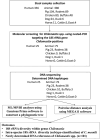Genetic diversity of genus Chilomastix: molecular classification of C. mesnili and other potential species variations in humans and animals
- PMID: 40140892
- PMCID: PMC11948686
- DOI: 10.1186/s41182-025-00725-5
Genetic diversity of genus Chilomastix: molecular classification of C. mesnili and other potential species variations in humans and animals
Abstract
Background: The genus Chilomastix, including C. mesnili, consists of protozoa that parasitize the gastrointestinal tracts of various host organisms, including mammals (humans and non-human primates [NHP]), birds, and amphibians. Despite its widespread presence, Chilomastix spp. are generally considered non-pathogenic, which has led to limited molecular epidemiological studies on this genus. Consequently, genetic reference data for this genus remain scarce in GenBank. In this study, we aimed to establish a molecular classification for Chilomastix spp. by investigating the genetic diversity of isolates from humans and animals in a parasite-endemic region of Indonesia.
Methods: A cross-sectional molecular investigation was conducted in Wainyapu Village, Sumba Island, Indonesia. Stool samples were collected annually from 2013 to 2016 and screened using polymerase chain reaction (PCR) targeting the 18S small subunit ribosomal RNA gene (18S rRNA) of Chilomastix spp., followed by direct and subcloning sequencing. Genetic haplotypes of the partial 18S rRNA sequence (1386-1953 bp) from humans (n = 25), dogs (n = 1), pigs (n = 23), rats (n = 38), water buffaloes (n = 3), chickens (n = 10), and ducks (n = 1) were analyzed alongside reference sequences from humans, guinea pigs, leeches, frogs, and water sources using phylogenetic analyses.
Results: The prevalence of Chilomastix spp. was 7.0% (25/356) in humans and 19.7% (75/380) in animals. Phylogenetic analyses revealed the following monophyletic clusters as subtypes (STs): C. mesnili ST1 (human-NHP genotype), C. mesnili ST2-1 (human genotype), and C. mesnili ST2-2 (pig genotype). In addition, C. gallinarum-like haplotypes (chicken genotype) and C. bettencourti-like haplotypes, including ST1 (rat genotype) and ST2 (rat-buffalo genotype), were also identified.
Conclusions: The genetic references registered in this study, along with the revealed molecular classification of Chilomastix spp., are crucial for understanding the genetic diversity and host-specific dynamics of these parasites in endemic regions.
Keywords: Chilomastix mesnili; Genetic diversity; Genus Chilomastix; Molecular taxonomy.
© 2025. The Author(s).
Conflict of interest statement
Declarations. Ethics approval and consent to participate: This study was approved by the scientific and ethics review unit at the Faculty of Medicine, Hasanuddin University, Makassar, Indonesia, and Kanazawa University, Japan. Informed consent and assent were obtained from the study participants (children) and their guardians. Consent for publication: Not applicable. Competing interests: The authors declare no competing interests.
Figures




References
-
- Leiva L. Observations on Chilomastix intestinalis Kuczinski. J Parasitol. 1921;8:49–57.
-
- Hegner RW. Giardia and Chilomastix from monkeys, Giardia from the wild cat and Balantidium from the sheep. J Parasitol. 1924;11:75–8.
-
- Wenyon CM. A new flagellate (Macrostoma mesnili n. sp.) from the human intestine with some remarks on the supposed cysts of Trichomonas. Parasitology. 1910;3:210–6.
-
- Haickei EH. The classification of lower organisms. Copyright by H.F. Copeland, Pacific Books, Palo Alto, California; 1956. p 165.
-
- Morimoto N, Korenaga M, Komatsu C, Sugihara S, Nishida M, Yasuoka M, Kumazawa H, Sasaki M, Hashiguchi Y. A case report of an overseas-traveler’s diarrhea probably caused by Chilomastix mesnili infection. Jpn J Trop Med Hyg. 1996;24:177–80.
Grants and funding
LinkOut - more resources
Full Text Sources
Miscellaneous
